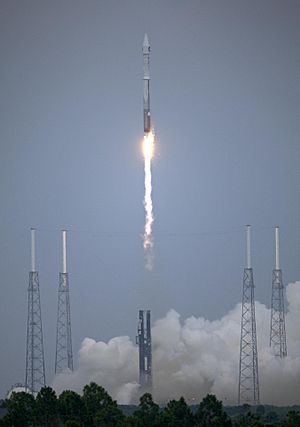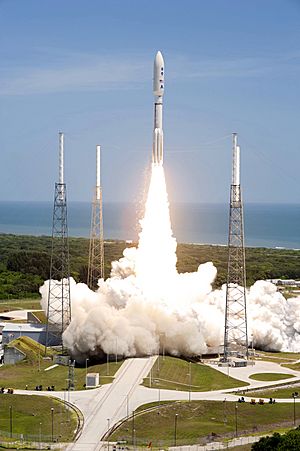Atlas V facts for kids

Atlas V is a type of rocket used by the United Launch Alliance (made of two companies, Boeing and Lockheed Martin) place satellites into orbit. It is 58.3 meters tall, and 3.81 meters wide. It has flown 67 times, since its first flight on 21 August 2002. It was developed from the Atlas (missile). Unlike the Space Shuttle, Atlas V is only used once, with a new rocket being built for each flight.
Contents
Flights
So far, the Atlas V has made 62 flights. The most famous ones had New Horizons, Mars Science Laboratory (which had the Curiosity rover in it), Juno, the Mars Reconnaissance Orbiter, the Lunar Reconnaissance Orbiter/LCROSS, and the Boeing X-37B on them.
Types
The Atlas V has a special way of naming the different kinds. The first number says how wide the fairing is. A 400 series Atlas V has a 4-meter wide fairing. A 500 series Atlas V has a 5-meter wide fairing. The second number says how many strap-on solid rocket boosters the rocket has. An Atlas V 501 has no strap-on boosters, but an Atlas V 421 has 2 strap-on boosters. The last number says how many engines the Centaur second stage has. All of the Atlas V rockets flown have had only 1 engine on the Centaur, but in the future other Atlas V rockets will have 2 engines on the Centaur second stage. There is also the HLV which has two of the first stage (Common Core Booster) strapped on like strap-on boosters, but it has never flown.
Description
The rocket is made of the first stage, a Common Core Booster with an RD-180 engine from Russia. Every Atlas V has this as the first stage. The second stage is called Centaur, and has one/two RL-10 engines from Aerojet Rocketdyne. On top is a 4-5 meter wide fairing covering the spacecraft during launch.
Images for kids
-
X-37B OTV-1 (Orbital Test Vehicle) being encased in its payload fairing for its 22 April 2010, launch.
-
An Atlas V 551 with the New Horizons probe launches from Launch Pad 41 in Cape Canaveral.
See also
 In Spanish: Atlas V para niños
In Spanish: Atlas V para niños









